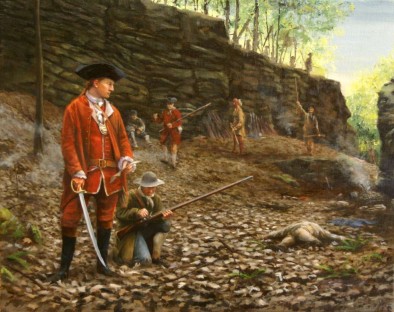Event Date: May 28, 1754
Battle between French and British provincial forces that marked the start of the French and Indian War. Following the 1748 Treaty of Aix-la-Chapelle, Britain and France attempted to negotiate an end to a border dispute between their North American empires. While the diplomats talked, British traders moved across the Allegheny Mountains into western Pennsylvania, and the French government in Canada attempted to protect their influence in the same area. Minor frontier squabbles gained new importance on April 15, 1754, when French forces evicted workmen from a nearly completed blockhouse at the forks of the Ohio River. The French then completed the blockhouse and expanded the fortifications, which they renamed Fort Duquesne, using it as a base to stop English incursions into the Ohio Country.
On suspicion that British provincial forces were operating west of the Alleghenies, the commander of Fort Duquesne, Claude- Pierre Pécaudy de Contrecoeur, sent Ensign Joseph Coulon de Villiers de Jumonville and a scouting party of 35 men to discover the whereabouts of the English. The English forces in question were some 150 Virginia militiamen and a handful of native allies operating under Lieutenant Colonel George Washington, whom Virginia’s Lt. Gov. Robert Dinwiddie had ordered to secure the Forks of the Ohio. Dividing his force into smaller scouting parties, Washington and approximately 47 men caught up with Jumonville in the Allegheny foothills on May 28, 1754.
Earlier that morning, Washington had called a council of war that included Tanaghrisson (Half-King), whose scouts had led the British to Jumonville’s camp. While the Virginians took up positions around the encampment, Washington’s native allies moved to the French rear. The French, meanwhile, prepared their breakfasts, probably unaware of the danger lurking around them.
It is impossible from known records to determine who fired first, or how the skirmish developed. Within 10 or 15 minutes, however, a single Virginian was dead and 2 were wounded. And the French had suffered 12 to 14 casualties. A cease-fire was quickly called, and the Virginians prepared to allow the wounded Jumonville to read his orders.
The ensign had little time to explain his summons-still less to discuss it-before Tanaghrisson attacked him. Half-King said to Jumonville, “You are not yet dead, my father,” a reference to the French practice of paternalistic benevolence toward their American Indian allies, before splitting open the latter’s head with a hatchet and washing his hands in the dead man’s brain, an old Iroquois custom. Washington’s other native allies soon followed suit, killing other French soldiers until only a single injured Frenchman remained alive. The 20 other unwounded Canadians remained untouched and soon became Washington’s prisoners. Commentators for both sides have argued whether the action at Jumonville’s Glen was a skirmish or a massacre, and whether the ensign’s death was an assassination by Washington’s order or an unfortunate oversight by a novice officer.
After the incident, Washington consolidated his forces, withdrew about 10 miles, and began to construct the aptly named Fort Necessity. Meanwhile, an expedition of revenge set out from Fort Duquesne under Jumonville’s brother, Captain Louis Coulon de Villiers. This force of 600 Canadians and 100 native allies caught up with Washington and his 500 colonial militiamen on July 3, 1754, and forced their surrender. After thus encounter, both sides began mobilizing for a large-scale conflict that became the French and Indian War.
References Anderson, Fred. Crucible of War: The Seven Years’ War and the Fate of the Empire in British North America, 1754-1766. New York: Knopf, 2000. Frégault, Guy. Canada: The War of the Conquest. Translated by Margaret M. Cameron. London: Oxford University Press, 1969. Leduc, Gilbert F. Washington and “the Murder of Jumonville.” Boston: Société Historique Franco-Americaine, 1943.
